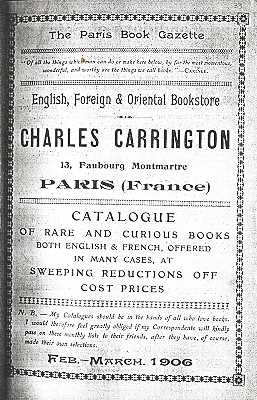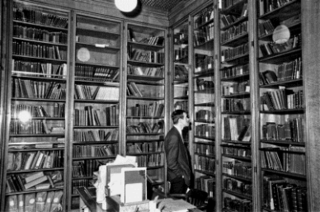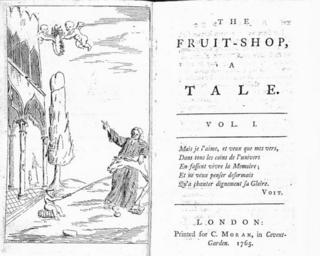Related Research Articles
The role of sadism and masochism in fiction has attracted serious scholarly attention. Anthony Storr has commented that the volume of sadomasochist pornography shows that sadomasochistic interest is widespread in Western society; John Kucich has noted the importance of masochism in late-19th-century British colonial fiction. This article presents appearances of sadomasochism in literature and works of fiction in the various media.
Theresa Berkley or Berkeley was a 19th-century English dominatrix who ran a brothel in Hallam Street, just to the east of Portland Place, Marylebone, London, specialising in flagellation. She is notable as the inventor of the "chevalet" or "Berkley Horse", a BDSM apparatus.

Erotic literature comprises fictional and factual stories and accounts of eros intended to arouse similar feelings in readers. This contrasts erotica, which focuses more specifically on sexual feelings. Other common elements are satire and social criticism. Much erotic literature features erotic art, illustrating the text.

Henry Spencer Ashbee was a book collector, writer and bibliographer. He is notable for his massive, clandestine three-volume bibliography of erotic literature published under the pseudonym of Pisanus Fraxi.
Rosa Coote is a fictional dominatrix appearing as a stock character in a number of works of Victorian erotica, including The Convent School, or Early Experiences of A Young Flagellant by William Dugdale and "Letters to a Lady Friend" or "Miss Coote's Confession" in The Pearl. Henry Spencer Ashbee writes of The Convent School that "The book is not altogether badly written; no part of the narrative however is attractive".
The Romance of Lust, or Early Experiences is a Victorian erotic novel written anonymously in four volumes during the years 1873–1876 and published by William Lazenby. Henry Spencer Ashbee discusses this novel in one of his bibliographies of erotic literature. In addition the compilers of British Museum General Catalogue of Printed Books list this book.

Charles Carrington (1857–1921) was a leading British publisher of erotica in late-19th- and early-20th-century Europe. Born Paul Harry Ferdinando in Bethnal Green, England on 11 November 1867, he moved in 1895 from London to Paris where he published and sold books in the rue Faubourg Montmartre and rue de Chateaudun; for a short period he moved his activities to Brussels. Carrington also published works of classical literature, including the first English translation of Aristophanes' "Comedies," and books by famous authors such as Oscar Wilde and Anatole France, in order to hide his "undercover" erotica publications under a veil of legitimacy. His books featured the erotic art of Martin van Maële. He published a French series La Flagellation a Travers le Monde mainly on English flagellation, identifying it as an English predilection.
Edward Sellon (1818–1866) was an English writer, translator, and illustrator of erotic literature.
James Campbell Reddie was a 19th-century British solicitor, collector and author of pornography, who, writing as "James Campbell", worked for the publisher William Dugdale. According to Henry Spencer Ashbee, Reddie was self-taught and viewed his works from a philosophical point of view.
The Romance of Chastisement is a Victorian pornographic collection on the theme of flagellation by St George Stock and published by John Camden Hotten in 1866. It was reprinted by William Lazenby in 1883 and again by Charles Carrington in 1902 as The Magnetism of the Rod or the Revelations of Miss Darcy.

The Private Case is a collection of erotica and pornography held initially by the British Museum and then, from 1973, by the British Library. The collection began between 1836 and 1870 and grew from the receipt of books from legal deposit, from the acquisition of bequests and, in some cases, from requests made to the police following their seizures of obscene material.
George Cannon (1789–1854) was an English solicitor, radical activist and publisher and pornographer who also used the pseudonyms Erasmus Perkins and Philosemus.
James Glass Bertram was a British author.
The Birchen Bouquet is a work of pornography first published around 1770, reprinted in 1826 by George Cannon, in 1860 by William Dugdale and again in 1881 by William Lazenby. It consists of a compilation of flagellation stories, mainly of women by women, some taken from The Englishwoman's Domestic Magazine. Henry Spencer Ashbee described it as "very ordinary and insipid", expressing surprise at its frequent reprinting.

Exhibition of Female Flagellants is an 1830 pornographic novel published by George Cannon in London and attributed, probably falsely, to Theresa Berkley. The principal activity described is flagellation, mainly of women by women, described in a theatrical, fetishistic style. It was republished around 1872 by John Camden Hotten in his series The Library Illustrative of Social Progress, attributed to Theresa Berkley.
The Rodiad is a pornographic poem on the subject of flagellation published by John Camden Hotten in 1871, although falsely dated to 1810. It was falsely ascribed when printed to George Colman the Younger. Its author was Richard Monckton Milnes. Henderson places it in The Library Illustrative of Social Progress published around 1872 but it is not in the list of Henry Spencer Ashbee.

Fashionable Lectures: Composed and Delivered with Birch Discipline was a pornographic book originally published in the 18th century and republished by John Camden Hotten as volume 7 of his series The Library Illustrative of Social Progress around 1872. Hotten claimed to have found them in the library of Henry Thomas Buckle (1821–1862) but Henry Spencer Ashbee claimed that they were in fact from his collection. The first edition was published around 1750 and again with illustrations by William Holland in the 1780s.
Experimental Lecture is an English pornographic book published in 1878 by the pseudonym "Colonel Spanker" for the "Cosmopolitan Society of Bibliophiles", an imprint of Charles Carrington. The Colonel and his circle have a house in Park Lane where genteel young ladies are kidnapped, humiliated, and flagellated.

Victorian erotica is a genre of sexual art and literature which emerged in the Victorian era of 19th-century Britain. Victorian erotica emerged as a product of a Victorian sexual culture. The Victorian era was characterized by paradox of rigid morality and anti-sensualism, but also by an obsession with sex. Sex was a main social topic, with progressive and enlightened thought pushing for sexual restriction and repression. Overpopulation was a societal concern for the Victorians, thought to be the cause of famine, disease, and war. To curb the threats of overpopulation and to solve other social issues that were arising at the time, sex was socially regulated and controlled. New sexual categories emerged as a response, defining normal and abnormal sex. Heterosexual sex between married couples became the only form of sex socially and morally permissible. Sexual pleasure and desire beyond heterosexual marriage was labelled as deviant, considered to be sinful and sinister. Such deviant forms included masturbation, homosexuality, prostitution and pornography. Procreation was the primary goal of sex, removing it from the public, and placing it in the domestic. Yet, Victorian anti-sexual attitudes were contradictory of genuine Victorian life, with sex underlying much of the cultural practice. Sex was simultaneously repressed and proliferated. Sex was featured in medical manuals such as The Sexual Impulse by Havelock Ellis and Functions and Disorders of Reproductive Organs by William Acton, and in cultural magazines like The Penny Magazine and The Rambler. Sex was popular in entertainment, with much of Victorian theatre, art and literature including and expressing sexual and sensual themes.

The Fruit-Shop, a Tale is an anonymous work of satire with erotic themes printed at London by C. Moran in 1765. A second edition was printed in 1766 for J. Harrison, near Covent Garden. The text is, for the most part, an allegorical and discursive disquisition on the "Fruit-Shop", as the author calls woman, or rather on those parts of her which are more particularly connected with fruit-bearing.
References
- 1 2 Ashbee (1877) pp. 240-241
- ↑ Bloch, Iwan (1938). Sexual Life in England, Past and Present. F. Aldor.; translated by William H. Forstern.
- ↑ Hoe, Robert (2008). A Catalogue of Books in English Later Than 1700, Volume 1. BiblioBazaar. p. 92. ISBN 978-0-554-42753-9.
- ↑ Ginzburg, Ralph (1958). An unhurried view of erotica . Helmsman Press. p. 55.
- ↑ Crawford, Katherine (2007). European sexualities, 1400-1800. New approaches to European history. Vol. 38. Cambridge University Press. p. 223. ISBN 978-0-521-83958-7.
- ↑ Henderson (2008) p.13
- 1 2 3 4 Prins, Yopie (1999). Victorian Sappho. Princeton University Press. p. 152. ISBN 0-691-05919-5.
- ↑ Greenspan, Ezra; Rose, Jonathan (2000). Book History, Volume 3. Penn State Press. p. 70. ISBN 0-271-02050-4.
- ↑ Fowler, Patsy; Jackson, Alan (2003). Launching Fanny Hill: essays on the novel and its influences. AMS studies in the eighteenth century. Vol. 41. AMS Press. p. 169. ISBN 0-404-63541-5.
- ↑ Binhammer, Katherine (2003). "The "Singular Propensity" of Sensibility's Extremities: Female Same-Sex Desire and the Eroticization of Pain in Late-Eighteenth-Century British Culture". GLQ: A Journal of Lesbian and Gay Studies. 9: 471–498. doi:10.1215/10642684-9-4-471. S2CID 144739362.
- ↑ Ashbee (1877) pp.257-258
- ↑ Thomas, Donald (1969). A long time burning. Taylor & Francis. p. 278.
- ↑ Alexander, David S. (1998). Richard Newton and English caricature in the 1790s. Manchester University Press ND. p. 58. ISBN 0-7190-5480-X.
- ↑ Largier, Niklaus; Harman, Graham (2007). In praise of the whip: a cultural history of arousal. Zone Books. p. 339. ISBN 978-1-890951-65-8.
- ↑ Henderson (1998) p.276
- ↑ Hurwood, Bernhardt J. (1965). The golden age of erotica. Sherbourne Press. pp. 166–167.
- ↑ Henderson (1998) p.15
- ↑ Henderson (2008) p.220
- Henderson, Andrea K. (2008). Romanticism and the painful pleasures of modern life. Cambridge studies in Romanticism. Vol. 75. Cambridge University Press. p. 220. ISBN 978-0-521-88402-0.
- Ashbee, Henry Spencer (1877). Index Librorum Prohibitorum: being Notes Bio- Biblio- Icono- graphical and Critical, on Curious and Uncommon Books. London: privately printed.